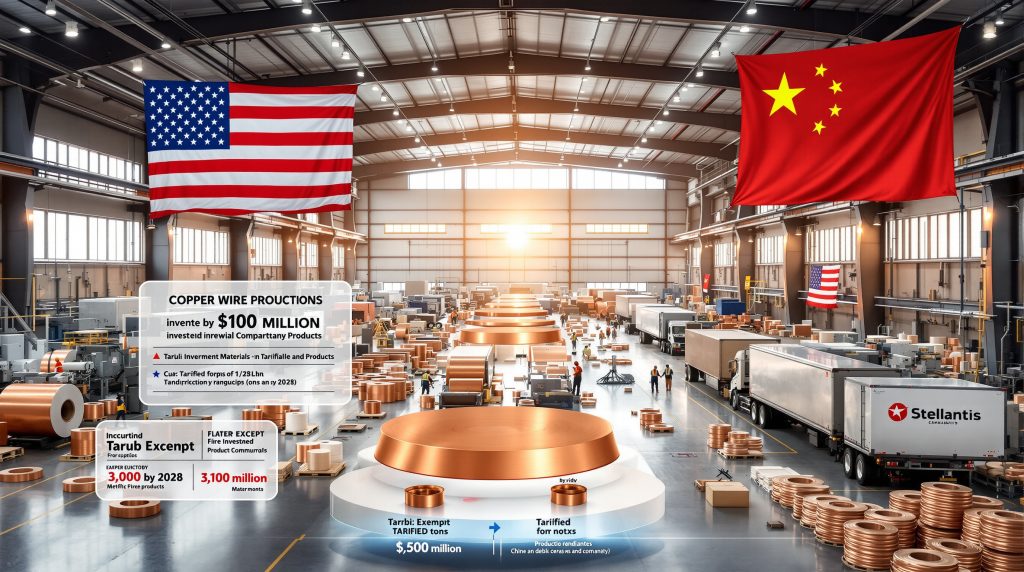Understanding the Strategic Move of Chinese Copper Manufacturing to US Soil
In a significant development for the manufacturing sector, a Chinese copper firm's $100 million investment in a Texas factory represents a strategic pivot that turns trade barriers into competitive advantages. The Grand Prairie, Texas manufacturing facility, set to begin operations in late 2025, marks a calculated response to evolving US‑China trade impact dynamics and demonstrates how foreign manufacturers can adapt to challenging tariff environments.
The Texas factory stands as a protective shield against the 50% tariff currently imposed on imported copper wire and other semi-finished copper products. By establishing production capabilities directly on US soil, the company has effectively circumvented these substantial import duties while maintaining access to refined copper—the essential raw material that remains exempt from tariffs.
The Strategic Shift to US-Based Production
The three-year investment plan in the Texas facility aims to achieve an annual production capacity of 3,000 metric tons of copper flat wire by 2028. This manufacturing approach represents more than just a tariff avoidance strategy; it's a comprehensive response to the geopolitical uncertainties affecting US-China trade relations.
"A factory in the US means the copper tariffs have in turn become a golden opportunity for us," a board member at the Chinese copper company told Reuters during a factory tour in August. This perspective highlights how tariffs impact on investments can sometimes create unexpected competitive advantages for forward-thinking businesses.
The strategic positioning behind the Texas location provides dual benefits: it eliminates tariff concerns for US customers while offering proximity to major automotive and industrial markets across North America. The company has already secured Stellantis, a major automotive manufacturer, as a client for its locally produced copper products.
Key Market Advantages for US-Based Operations
The decision to manufacture in Texas creates several distinct competitive advantages:
- Tariff exemption: While imported copper wire faces a 50% tariff, producing locally eliminates this substantial cost barrier
- Raw material access: Refined copper, the base ingredient for manufacturing, remains exempt from US tariffs, creating a cost-effective supply chain
- Supply chain security: US customers gain stability and predictability in their supply chains, eliminating concerns about international shipping disruptions
- Client confidence: American buyers who previously hesitated due to concerns about trade tensions now have assurance of consistent local supply
The facility is projected to generate more than half of the company's overseas revenue within three years of operation, highlighting the substantial market opportunity created by manufacturing behind tariff walls. This approach transforms what could have been a market barrier into a competitive advantage.
What Challenges Do Chinese Manufacturers Face When Expanding to the US?
Chinese manufacturers seeking to establish US operations must navigate complex regulatory environments, shifting trade policies, and bilateral tensions that can rapidly change investment conditions. Despite these obstacles, the Texas copper facility represents a successful case of adaptation in a challenging climate.
Navigating Regulatory Hurdles
Establishing manufacturing operations in the United States requires Chinese companies to secure approval from authorities in both countries—a process that has grown increasingly complex amid heightened geopolitical tensions. The Chinese copper manufacturer's investment narrowly avoided derailment when temporary equipment tariffs threatened the project's viability.
In April 2025, a temporary 145% tariff on equipment shipments to the US nearly forced the company to reconsider its investment plans entirely. This unexpected development would have increased facility costs by approximately 60%. Fortunately, a trade truce reached in May 2025 provided relief, allowing equipment shipments to proceed. This 90-day extension, recently renewed, has created crucial operational breathing room for the project.
The regulatory path illustrates the precarious nature of cross-border manufacturing investments in the current climate:
- Dual approval requirements from Chinese and US regulatory bodies
- Exposure to rapidly changing tariff policies that can affect equipment imports
- Dependency on broader trade negotiations beyond the company's control
- Need for contingency planning to address sudden policy shifts
These hurdles highlight why many Chinese enterprises have hesitated to pursue US copper investment insight despite potential market advantages.
Broader Investment Climate Concerns
The broader context for Chinese manufacturing investments in the United States has been increasingly challenging since 2019. Government data shows that the net stock of Chinese foreign direct investment in the US declined by $8.1 billion between 2019 and 2023, reflecting growing hesitancy among Chinese companies to commit capital to American operations.
"Anybody who is big and could be a target for US or Chinese governments is doing hardly any investment," noted Cameron Johnson, senior partner at consultancy Tidalwave Solutions. "The hostile attitude in Washington is now echoed in Beijing where regulators are encouraging firms to avoid the US."
This regulatory skepticism from both sides has created particular challenges for high-profile Chinese enterprises that might attract political scrutiny. However, medium-sized companies often face fewer obstacles, as they typically attract less attention from policymakers on either side.
This dynamic suggests that the future of Chinese manufacturing investment in the US may increasingly depend on smaller, specialized enterprises rather than national champions or state-affiliated corporations. For companies operating below the political radar, manufacturing opportunities may remain accessible despite broader bilateral tensions.
How Does This Case Study Compare to Other Chinese Investments in the US?
The Texas copper factory stands out as an unusual success story against the backdrop of declining Chinese manufacturing investments in the United States. While many Chinese enterprises have withdrawn or reduced their American operations, this case demonstrates an alternative approach that may inform future investment strategies.
Contrasting Experiences Across Industries
Recent years have revealed stark differences in how various industries navigate US-China manufacturing tensions:
- Automotive sector: Ford's electric battery plant using technology from Chinese battery manufacturer CATL faced significant political scrutiny and challenges regarding tax credit eligibility, though Ford maintains it will still qualify
- Solar industry: Domestic US producers have expressed concerns that Chinese competitors establishing factories in America benefit from subsidized supply chains in their home country
- High-tech manufacturing: Companies in sensitive sectors face intensified scrutiny from both American and Chinese regulators, often making investments impractical
- Medium-sized specialized manufacturing: Firms in less politically sensitive sectors have found greater success, particularly when addressing specific market niches
The copper manufacturer's experience suggests that industry positioning, company size, and product category significantly influence investment outcomes in the current environment. Medium-sized enterprises focused on industrial materials may face fewer political obstacles than high-profile technology companies or businesses in sectors deemed strategically important.
Potential Model for Future Investments
The success of the Texas copper facility could serve as a template for other Chinese manufacturers if bilateral relations improve. Industry experts suggest that this approach—manufacturing behind tariff walls while maintaining access to exempt raw materials—might become more common if current trade negotiations yield positive results.
Several factors make this case potentially replicable:
- Focused on industrial inputs rather than consumer-facing products
- Delivers clear economic benefits to the US manufacturing ecosystem
- Creates American jobs while addressing supply chain concerns
- Operates at a scale significant enough to be viable but not large enough to trigger heightened scrutiny
"Their example was pretty unusual, but maybe, if the relationship gets a bit better, we might see more of it because there are test cases out there in the market," Johnson observed. This assessment suggests that the copper manufacturer's approach could become more widely adopted if current trade tensions ease.
What Economic Benefits Result From This Manufacturing Strategy?
The decision to establish copper manufacturing operations in Texas delivers substantial economic advantages that extend beyond simple tariff avoidance. By positioning production within the United States, the company has created a differentiated market position with significant revenue potential.
Revenue and Growth Projections
The Texas facility is expected to generate more than half of the company's overseas revenue within three years of operation, highlighting the substantial market opportunity created by US-based manufacturing. With a projected annual production capacity of 3,000 metric tons of copper flat wire by 2028, the plant will establish a significant presence in the North American copper products market.
This production capability positions the company to serve several key market segments:
- Automotive manufacturing supply chains, including established partnerships with major manufacturers like Stellantis
- Industrial applications requiring high-performance copper components
- Electronics and electrical equipment producers seeking reliable domestic supply
- Infrastructure projects requiring copper products for electrical systems
Importantly, the facility creates a competitive advantage against other Chinese manufacturers who continue to face the 50% tariff barrier when exporting finished copper products to the US market. This differential creates pricing power and market access advantages that could persist even if trade relations normalize.
Alignment With US Industrial Policy Goals
The Texas factory aligns with several core US industrial policy objectives, creating a win-win scenario despite broader trade tensions:
- Domestic manufacturing capacity: Establishes production of important industrial inputs on American soil
- Job creation: Generates employment opportunities in manufacturing and related sectors
- Supply chain resilience: Reduces dependency on overseas shipping and international logistics
- Value-added processing: Performs higher-value manufacturing stages within US borders
- Local economic development: Contributes to the industrial base of the Grand Prairie, Texas region
This alignment with policy priorities helps explain why the investment received necessary approvals despite the challenging bilateral relationship. For US policymakers seeking to rebuild domestic manufacturing capabilities, such investments can represent welcome additions to the industrial landscape even when originating from strategic competitors.
How Might Future US-China Trade Relations Impact Similar Investments?
The copper manufacturer's Texas facility exists within a fluid trade policy environment that continues to evolve. Future developments in US-China relations will significantly influence whether this case remains an exception or becomes a template for other Chinese manufacturers considering American operations.
Potential Scenarios Under Evolving Trade Policies
Several possible trajectories could emerge from current trade negotiations:
- Successful comprehensive agreement: A broad trade deal resolving major points of contention could encourage similar investments by reducing uncertainty and creating stable regulatory frameworks
- Targeted sector-specific arrangements: Agreements covering specific industries might create investment opportunities in select manufacturing categories while maintaining barriers in others
- Continued tension with temporary truces: Extension of the current approach, with periodic negotiations preventing escalation but failing to resolve underlying issues
- Renewed tariff escalation: Breakdown in negotiations leading to expanded trade barriers that further discourage cross-border investment
Recent developments suggest cautious optimism, with Donald Trump indicating a trade deal is "not far off" and both sides extending negotiation timeframes. However, structural tensions between the world's two largest economies mean uncertainty will likely persist even with incremental improvements in relations.
Strategic Considerations for Manufacturers
The current tariff structure creates specific incentives for value-added processing within US borders, particularly when raw materials remain exempt from duties. This dynamic shapes strategic options for Chinese manufacturers:
- Behind-tariff manufacturing: Establishing operations within US borders to serve the American market directly
- Third-country processing: Routing production through countries with preferential trade agreements with both China and the US
- Domestic market focus: Prioritizing Chinese and non-US markets to reduce exposure to trade volatility
- Technology licensing: Partnering with US firms rather than establishing direct operations
Medium-sized enterprises may continue to find greater success than high-profile national champions, as they typically attract less regulatory scrutiny. Geographic diversification across multiple markets serves as a hedge against unpredictable trade policies, allowing manufacturers to adapt production locations based on evolving conditions.
FAQ: Chinese Manufacturing in the US Amid Trade Tensions
What specific products are affected by the 50% copper tariffs?
The 50% tariffs apply to semi-finished copper products including wire, tubes, and formed components. Importantly, refined copper—the raw material used in manufacturing these products—remains exempt from these tariffs. This differential creates the strategic opportunity for localized manufacturing, where companies can import tariff-free raw materials while producing finished goods domestically to avoid import duties.
How do US customers benefit from Chinese manufacturers establishing local facilities?
American customers gain several advantages from locally established manufacturing operations:
- Elimination of tariff-related price increases on finished products
- Reduced supply chain uncertainty compared to overseas sourcing
- Faster delivery times and reduced logistics complications
- Easier technical collaboration and quality control processes
- Protection from potential future trade policy changes
These benefits make locally produced goods increasingly attractive in an environment where Trump tariffs effect creates unpredictability for import-dependent supply chains.
What factors allowed this copper manufacturer to succeed where other Chinese companies have struggled?
Several key factors contributed to the company's successful investment:
- Operating as a medium-sized enterprise rather than a high-profile national champion
- Focusing on industrial inputs rather than consumer-facing products
- Addressing a specific market need with clearly defined customers
- Timing investments to coincide with trade negotiation windows
- Maintaining flexibility to adapt to changing regulatory conditions
This combination of factors allowed the company to navigate regulatory hurdles that have derailed larger or more politically sensitive investments.
How might upcoming trade negotiations impact similar investment decisions?
Current negotiations between the US and China will significantly influence future investment patterns. Successful talks that reduce uncertainty would likely encourage more Chinese manufacturers to consider US operations, particularly those serving industrial supply chains. Conversely, continued tensions would likely limit this approach to smaller, less visible companies in non-strategic sectors.
The extension of the current trade truce provides a window for companies to assess market conditions and prepare contingency plans for different policy outcomes. This breathing room allows for more deliberate investment planning rather than reactive decisions driven by sudden tariff changes.
Strategic Adaptation in a Challenging Trade Environment
The Texas copper factory represents a compelling example of strategic adaptation to evolving trade barriers. By establishing manufacturing operations behind tariff walls while maintaining access to exempt raw materials, the Chinese company has transformed potential market exclusion into competitive advantage.
This approach delivers multiple benefits: it shields US customers from tariff-induced price increases, creates supply chain stability in an uncertain environment, and positions the manufacturer for substantial revenue growth in the North American market. With projected annual production of 3,000 metric tons of copper flat wire by 2028, the facility will establish a significant presence in its target markets.
The case stands as an unusual success story amid declining Chinese investment in US manufacturing. While net Chinese foreign direct investment in the United States fell by $8.1 billion between 2019 and 2023, this manufacturer found a viable pathway through complex regulatory terrain.
For industry observers, the Texas copper facility offers valuable insights into how manufacturing strategies can adapt to geopolitical realities. Whether this approach remains an exception or becomes a template for future investments will depend largely on the trajectory of US-China trade relations, which continue to evolve through ongoing negotiations.
As medium-sized enterprises navigate these complex waters, those that can operate below political radar while delivering tangible economic benefits may find continued opportunities for cross-border investment, even amid broader bilateral tensions. In fact, some experts expect to see adjustments in copper price prediction models based on these evolving manufacturing patterns.
Want to Capitalise on the Next Major Mineral Discovery?
Discovery Alert's proprietary Discovery IQ model instantly notifies investors of significant ASX mineral discoveries, turning complex data into actionable insights before the broader market responds. Explore why major mineral discoveries can lead to exceptional returns by visiting Discovery Alert's dedicated discoveries page and begin your 30-day free trial today.




